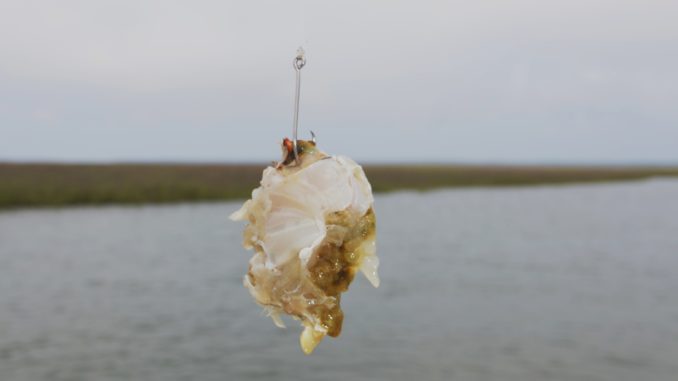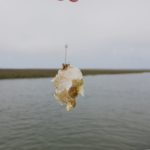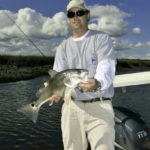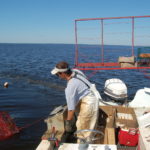
The spring molt by blue crabs sets the dinner table for some great April fishing for reds in both Carolinas. Try these spots and these tricks to get your string stretched.
Crab meat on the dinner table provides big smiles to just about anyone fond of creatures from the sea. For die-hard anglers who target redfish, it’s no surprise that fresh crab is the kryptonite for duping a red of any size to eat.
In spring, when the water temperatures rise in inshore waters up and down the coast of the Carolinas, blue crabs flood the estuaries and make their first molt of the year, causing a feeding craze.
Those waters are home to massive populations of blue crabs. The sprawling estuaries provide the ideal environment for them. North Carolina, in fact, boasts 2.5 million acres of ideal habitat from which the commercial fishing fleet extracts over 32 million pounds of crabs annually. According to the N.C. Division of Marine Fisheries, North Carolina crabbers’ haul outdistances the harvest of any other species, with shrimp a distant second, 20 to 25 million pounds behind
South Carolina’s blue crab production is significantly lower, at around four million pounds annually, but the habitat is only a half-million acres. The Palmetto State doesn’t have the huge Albemarle and Pamlico sounds that produce the overwhelming majority of the Old North State’s crab haul.
It’s no surprise that redfish and blue crabs coexist, which makes the spring molt an epic discovery for anglers not conditioned to using soft crabs for bait, but timing is everything. Crabs bury in the mud over the winter and will not emerge until spring. And the timing of the first spring molt will vary each year depending on the water temperature.
Clay Willis of Salmon Creek Guide Service in Edenton, N.C., once ran a spread of 300 crab pots in the Albemarle Sound. Water temperature was a key factor Willis used to determine when he needed to start deploying his pots.
“Most male crabs mud down for the winter in the sounds, and females migrate into the ocean,” said Willis (252-312-3692). “When water temperatures rise above 50 degrees, males get out of the mud, and females begin to move back into the sounds.”
In North Carolina, water temperatures will not reach that level inshore until late April or early May. Many of South Carolina’s waters, however, crack the 50-degree mark in early April in most years.
In order to grow, crabs must shed their hard shells, and they will do so at every opportunity. After living on fat reserves through the winter, crabs must molt in the spring soon after they emerge from the mud. According to Willis, the major wave of molting crabs showing up in his traps always seemed to coincide with a lunar event.
“We always expected a surge of soft crabs around the new and full moons right after they dig out of the mud,” Willis said.
The surge of soft crabs into the estuaries is an answer to prayers because the redfish bite can be incredible.
“I use a lot of crab throughout the year, but I love using soft crabs in the spring. It’s almost cheating,” said Chris Orvin of Overdose Fishing Charters in Charleston, S.C. (843-509-2306). “I will not leave the dock without at least two dozen in my cooler.”
Reds will eat soft crabs any time they can get them, but the spring rush is when it gets exciting. Orvin said the prime soft- crab bite usually arrives between early April and early May.
“A good indicator of when the crabs are molting locally is at the seafood markets. If the price has dropped from $22 per dozen to $12, they are local, and the crab bite is on,” he said.
Soft crabs might gather anywhere from shallow, backcountry flats to main creeks and waterways near the ocean. The best redfish bite will be in places with the highest concentrations of crabs, the caviar of the inshore marine world.
Orvin said his best spring redfish bit will usually be close to the ocean.
“In the spring, I concentrate on the main waterways near the ocean, targeting docks on the ICW with heavy oyster buildup or the oyster rakes at high tide,” Orvin said. “These areas are places where the reds will be showing up first from the ocean.”
Willis begins seeing the first influx of crabs on the eastern side of the Pamlico, Albemarle, Roanoke and Croatan sounds.
“Crabbers start fishing on the eastern side of the sounds and will move west later in the spring and into summer,” Willis said. “The fish will respond similarly, and most redfish will be concentrated in these eastern sounds early in season and will spread out upriver.”
Soft crabs are not the easiest baits to keep on the hook, so Orvin finds himself casting into small eddies and other places where strong currents, tidal or otherwise, are missing.
“I like to cast them in eddies and let them soak. You don’t want to move them much because it will fall off the hook,” said Orvin, who typically cuts crabs in halves or quarters and sticks a Calcutta circle-hook jig through one of their claw joints. That allows the bait to stay hooked for as long as needed.
“They will smell it and come and find it,” said Orvin, who has learned that keeping crabs ice cold firms them up and helps them stay on the hook longer.
“Usually, when we are using soft crabs, they don’t last long,” he said. “They get eaten quickly or will fall off the hook when they get to temperature. I precut my soft crabs and get them ice-cold in the cooler. It really seems to help.”
Regardless of the tide, time of day and the level of food in their stomachs, redfish will attack a chunk of soft crab every chance they get, and the first spring molt can be monumental for redfish and their dedicated anglers.







Be the first to comment